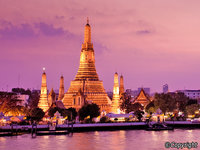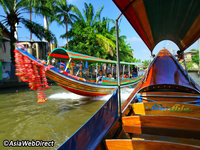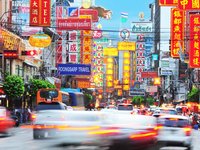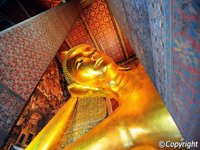Venue & Hospitality
Avani Atrium Bangkok, 1880 Phetchaburi Road, Bangkok 10310, Thailand
Conference Dates: July 03-05, 2017
Hotel Services & Amenities
- Audio/Visual Equipment Rental.
- Business Center.
- Business Phone Service.
- Complimentary Printing Service.
- Express Mail.
- Fax.
- Meeting Rooms.
- Office Rental.
- Photo Copying Service.
- Secretarial Service.
- Telex.
- Typewriter.
- Video Conference.
- Video Messaging.
- Video Phone.
- ATM.
- Baggage Storage.
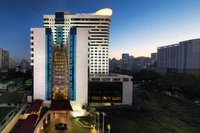
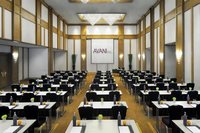
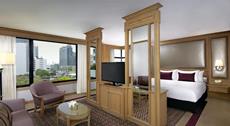
Transportation
Driving Directions to
Driving Directions to
- Suvarnabhumi International Airport is located about 20 kilometers East of Bangkok City and covers an area of about 8,000 acres. It can easily be reached via either Bangna-Trat Highway or from the Southern Bangna area, depending on the origin of the trip to the airport. A rail link connecting the airport's main building to the city center is being developed and due to open in 2010, in order to facilitate the access to and from the airport to town.
- Don Mueang Airport was Bangkok's former airport and it has been reassigned to some point to point domestic flights which are not connecting to international ones as well as charter operated flights. The airport code has been amended to DMK and it is very easily accessible expressway from downtown as well as if needed a connection to the New International Airport can be done easily via the elevated expressways. Since the numbers of flights is very limited, the airport has become very user friendly, and aside of Thai public holidays, is not too crowded. In addition, a Train station is available in short walking distance of the terminal allowing an easy commute to Hua Lomphong main station.
- The Suvarnabhumi Airport Rail Link starts its official operation since August 2010. To avoid Bangkok’s congestion, the 28.6 km journey from Bangkok to the international airport is elevated by the services of 30 minutes or less. The services are comprised of 2 lines, non-stop Express services and City Train services. Both lines operate from 06.00 am. – midnight. Non-stop Express services start at Suvarnabhumi Airport and terminate at Makkasan Station. The journey takes only 15 minutes and runs every 30 minutes. City Train or Commuter services run between Suvarnabhumi Airport, stop at Lat Krabang, Ban Thup Chang, Hua Mak, Makkasan, Ratchaprarop and Phaya Thai. The journey takes 27 minutes and runs every 15 minutes.
- Local buses, mostly operated by the Bangkok Mass Transit Authority (BMTA), are the cheapest but also the most challenging way of getting around, as there is a bewildering plethora of routes, usually marked only in Thai. If you can speak Thai you can call 184 Bus Route Hotline. Bus stops usually list only the bus numbers that stop there and nothing more. They are also subject to Bangkok's notorious traffic, often terribly crowded, and many are not air-conditioned. If you want to get somewhere quickly and are not prepared to get lost, the buses should be avoided (remember that taxis are cheaper than most local buses in the west). However, they make for a good adventure if you're not in a rush and you don't mind being the centre of attention.
Route Map
About City
Bangkok is the capital and most populous city of Thailand. The city occupies 1,568.7 square kilometres (605.7 sq mi) in the Chao Phraya River delta in Central Thailand, and has a population of over 8 million, or 12.6 percent of the country's population. Over 14 million people (22.2 percent) live within the surrounding Bangkok Metropolitan Region, making Bangkok an extreme primate city, significantly dwarfing Thailand's other urban centres in terms of importance.
Bangkok's rapid growth amidst little urban planning and regulation has resulted in a haphazard cityscape and inadequate infrastructure systems. The city has since turned to public transport in an attempt to solve this major problem. Four rapid transit lines are now in operation, with more systems under construction or planned by the national government and the Bangkok Metropolitan Administration.
The agriculture in Thailand is highly competitive, diversified and specialised and its exports are very successful internationally. Rice is the country's most important crop. Thailand is a major exporter in the world rice market. Rice exports in 2014 amounted to 1.3 percent of GDP. Agricultural production as a whole accounted for an estimated nine percent of Thai GDP and 40 percent of the population works in agriculture-related jobs. Agriculture was able to expand during the 1960s and 1970s as it had access to new land and unemployed labour. Between 1962 and 1983, the agricultural sector grew by 4.1 percent a year on average and in 1980 it employed over 70 percent of the working population.Yet, the state perceived developments in the agricultural sector as necessary for industrialisation and exports were taxed in order to keep domestic prices low and raise revenue for state investment in other areas of the economy.
Bangkok welcomes more visitors than any other city in the world and it doesn’t take long to realise why. Bangkok is a city of contrasts with action at every turn; marvel at the gleaming temples, catch a tuk tuk along the bustling Chinatown or take a longtail boat through floating markets. Food is another Bangkok highlight, from local dishes served at humble street stalls to haute cuisine at romantic rooftop restaurants.
Luxury malls compete with a sea of boutiques and markets, where you can treat yourself without overspending. Extravagant Luxury hotels and surprisingly cheap serviced apartments welcome you with the same famed Thai hospitality. And no visit to Bangkok would be complete without a glimpse of its famous nightlife – from cabarets to exotic red-light districts, Bangkok never ceases to amaze.

